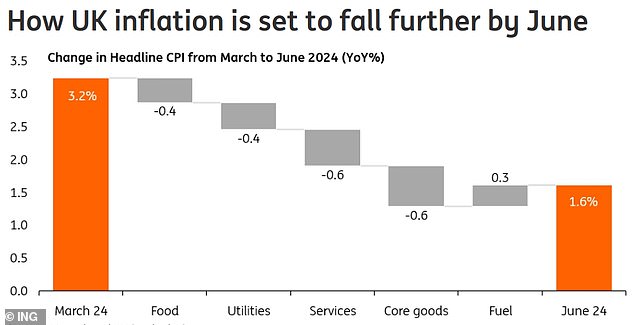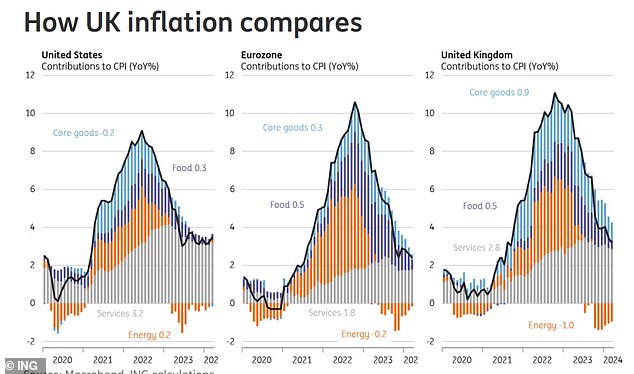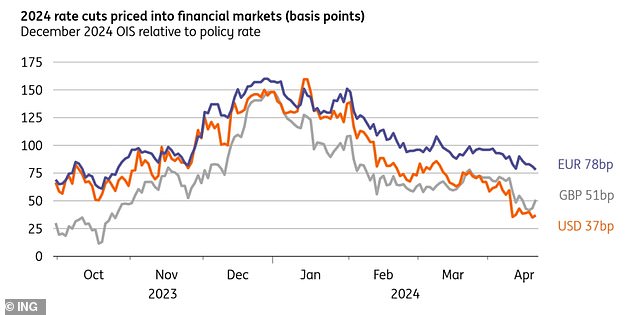Could the Bank of England really cut rates this week?
- The Bank’s MPC will meet on Thursday afternoon for an interest rate decision
- There is a chance that the bank will opt for a cut, but markets think this will wait until June
- The Bank is unlikely to take the risk of rising too quickly with the Fed sticking around
The Bank of England could get ahead of the US Federal Reserve and the European Central Bank this week with a first cut in key interest rates.
Markets are assessing a small but growing chance that the BoE’s Monetary Policy Committee will opt for a cut at its meeting on Thursday, following a more forgiving tone at its April meeting and an expected sharp decline in upcoming inflation figures.
The BoE is expected to cut the base rate twice in 2024, potentially raising it from the current level of 5.25 percent to 4.75 percent by the end of the year.
But forecasters say the extent of the BoE’s cuts will be limited by a slower start from the Fed, which faces a more persistent inflation picture amid concerns about the potential impact on sterling.
The Bank of England’s Monetary Policy Committee will meet on Thursday
Current market prices show a roughly 50 percent chance that the base rate will fall to 5 percent after the MPC meetings on May 9 and June 20.
The bank could choose to wait until April inflation data is released later this month, as inflation is expected to be much lower, falling to 3.4 percent in March.
According to ING forecasts, April data will reflect a 12 percent annual decline in energy bills, meaning much lower inflation in the core goods, food and services sectors.

Official inflation data is expected to show a sharp decline over the next two months
Nick Chatters, portfolio manager at Aegon Asset Management, said: ‘We will see a big drop in headline inflation for the April print.
‘That will be optically important for the market, but we know it is coming.
‘The bank’s communication so far, which is entirely reasonable, is that a rate cut is still on the table for June, but it will be subject to any surprises regarding that (CPI) figure – we would print a of less than 2 percent. , which would be optically very important.’
Markets are also now all but certain of an impending cut in eurozone interest rates in June, following the ECB’s recent dovish comments, improving growth rates and falling inflation.
But Chatters warned that both the BoE and ECB are likely to be subject to up to two cuts this year, amid the Fed’s concerns.
He said: “For 2024, we had six Fed cuts before the end of this year. We have just over one now and we have seen inflation go sideways.
“The BoE and the ECB can easily get started (with interest rate cuts), but they simply cannot continue without the Fed.”

US consumer price inflation remains stubbornly high
Can the BoE act before the Fed?
The chances of a BoE cut are more heavily influenced by the knowledge that a wider interest rate differential between Britain and the US would push sterling lower against the dollar, which would have a negative impact on capital flows and inflation.
Morgane Delledonne, head of investment strategy at Global This is counterproductive in reducing inflation as it would make imports more expensive, but will certainly improve the regions’ competitiveness and boost exports.
“The ECB and the BoE are likely to leave current interest rates unchanged and reduce demand themselves, as long as this is necessary to reduce inflation and as long as unemployment remains at record lows.”
The US Fed recently allayed fears that it could opt for a rate hike, but markets still don’t expect the US central bank to start cutting rates until September or even November.
Kristina Hooper, chief global markets strategist at Invesco, said there was a “possibility” of a rate cut by the BoE on Thursday, “especially after the Fed’s subdued performance last week.”
She added: ‘If there is no rate cut this week, I fully expect a dovish BoE to signal that rate cuts could start this summer, most likely in June, as the European Central Bank indicates.’
And analysts at ING believe the ‘link’ between Fed and BoE policies is ‘often overstated’, giving the British bank more room to diverge from the US interest rate cycle if it sees fit.
ING said: Concerns about the impact of a weaker currency have probably faded into the background.
‘Not only is inflation much lower and there is more confidence in the disfinancing in the pipeline, sterling has been one of the more resilient G10 currencies in the face of the dollar’s renewed strength.
‘In a sense, that provides a bit of a buffer against new weakness and the pass-through of inflation.
“In short, we don’t think the BoE will have much difficulty cutting rates at the Federal Reserve, nor will it move slightly faster in subsequent meetings.”

Expectations for an interest rate cut in 2024 are increasing in Britain than in the US

